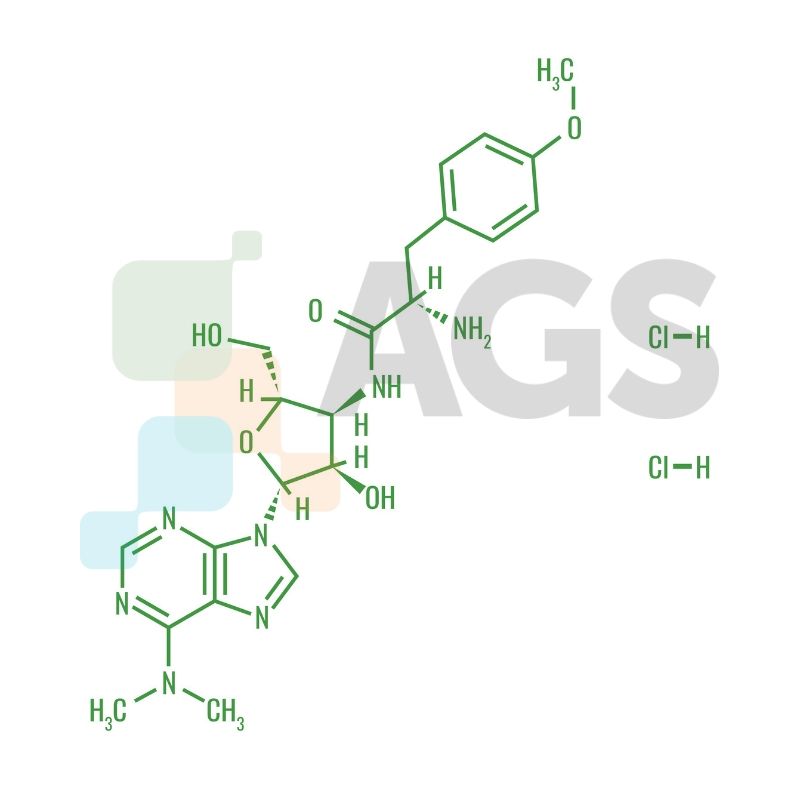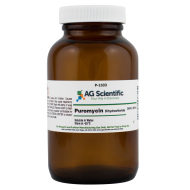Puromycin is an antibiotic researchers can use when working with cell cultures when they need a selective agent, a compound that will kill all cells without resistance genes, leaving only specific targets behind. This antibiotic is available through laboratory suppliers and is suitable for research purposes only.
Puromycin works by interrupting protein synthesis in both prokaryotic and eukaryotic cells. This causes cells to die, unless they have a gene for resistance, allowing them to survive exposure to the antibiotic. Researchers can tag specific cell types with this gene and grow them in culture with puromycin to create a pure culture. Any contamination will be eliminated by the antibiotic. Selective agents are useful for genetic engineering and other kinds of research where people want to be able to isolate particular kinds of cells.

How does Puromycin inhibit translation?
Puromycin is an aminonucleoside antibiotic, derived from the Streptomyces alboniger bacterium, that causes premature chain termination during translation taking place in the ribosome. Part of the molecule resembles the 3' end of the aminoacylated tRNA. It enters the A site and transfers to the growing chain, causing the formation of a puromycylated nascent chain and premature chain release. The exact mechanism of action is unknown at this time, but, the 3' position contains an amide linkage instead of the normal ester linkage of tRNA, the amide bond makes the molecule much more resistant to hydrolysis and thus causes the ribosome to become stopped.It is not selective for either prokaryotes or eukaryotes. Also of note, puromycin is critical in mRNA display. In this reaction, a puromycin molecule is chemically attached to the end of an mRNA template, which is then translated into protein. The puromycin can then form a covalent link to the growing peptide chain allowing the mRNA to be physically linked to its translational product. Antibodies that recognize puromycylated nascent chains can also be used to purify newly synthesized polypeptides and to visualize the distribution of actively translating ribosomes by immunofluorescence.
How is Puromycin used as a peptidase inhibitor?
Puromycin is a reversible inhibitor of dipeptidyl-peptidase II (serine peptidase) and cytosol alanyl aminopeptidase (metallopeptidase). The mechanism of inhibition is not well understood, however puromycin can be used to distinguish between aminopeptidase M (active) and cytosol alanyl aminopeptidase (inhibited by puromycin).What is Puromycin blockage?
Puromycin is O-Me tyrosyl dimethyladenosine, an aminoacyl tRNA analog that reacts with peptidyl tRNA to form peptidyl puromycin. Puromycin is a potent and specific inhibitor of tyrosine kinase activity in HL-60 cells. These results suggest that the blockage caused by puromycin is due to adsorption of peptidyl-puromycin to adrenergic sites and that these sites may be involved in the memory trace.After selection with puromycin, why are there no surviving cells?
The cells you are working with may be sensitive to puromycin. The concentration of puromycin added to the cells may be too high. For each new cell type used, it is recommended that a puromycin titration be performed to determine the lowest concentration of puromycin needed to efficiently select transfected or transduced cells. Also, be sure to wait 48 hours post-transduction before applying antibiotics to the cells. Alternatively, a higher MOI or transduction enhancement methods, such as Express Mag® may be required for an effective transduction.How should a Puromycin titration (kill curve) be set up?
1.Plate 1.6 x 104 cells into wells of a 96-well plate with 120 ml fresh media.2.The next day add 500-10,000 ng/ml of puromycin to selected wells.
3.Examine viability every 2 days.
4.Culture for 10-14 days. Replace the media containing puromycin every 3 days.
5.The minimum concentration of puromycin that causes complete cell death after 3-5 days should be used for that cell type.

